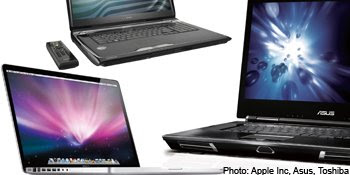Goodbye desktops, hello notebooks 
By Adli Yashir,
a correspondent/ Internet coordinator with Berita Harian
THE last time I bought a desktop PC was way before my teenage daughter was born. Since then, notebooks have been my preferred choice simply because they allow me to bring my work home and give me the flexibility to work away from the office.
It seems I am not the only one.
According to research firm iSuppli.com, notebooks have become increasingly popular.
Notebook shipments exceeded desktop shipments for the first time in the third quarter of last year - some 38.6 million notebooks were shipped compared to 38.5 million desktops.
Recently, I was tasked to develop new media content for my newspaper.
So apart from writing stories, I would also be in charge of creating videos, flash animation and graphics content.
This new assignment called for new equipment.
Desktops are out of the question as I needed a PC that allows me to work at home, at the office and when I travel.
My five-year-old Dell business laptop barely had the computing muscle to edit photos, let alone videos.
Calls to several contacts in the industry provided me with this option - a desktop replacement notebook.
These rigs are portable computing machines that come close, in features and capabilities, to that of a full-sized desktop computer.
They are usually larger than standard notebooks, have more components and a wide range of ports and slots.
Naturally, these big boys do not come cheap.
The Toshiba Qosmio, for example, can set you back $4,199.
At the top of my checklist is to look for a notebook with a powerful processor, one that allows me to work with Adobe Photoshop or Premiere with e-mail and Microsoft Word running in the background.
Toshiba's Qosmio G50-AV871 is one potential candidate.
It has an Intel Core 2 Duo 2.66GHz processor.
You can bump the memory up to 9GB RAM.
The 17-inch Macbook Pro is also a worthy option.
The top-end machine sports a 2.93GHz Intel Core 2 Duo processor with up to 8GB RAM.
Plus you get the cool iLife09 software bundle that lets you edit movies and videos.
Working with graphics and video content always require a bigger screen - it is better to see colour and video elements clearly.
I would put my money on a notebook with at least a 16-inch screen, which comes with a true 16.9 aspect ratio - great for viewing widescreen movies or editing high-definition videos.
A good desktop replacement notebook should also come with an equally powerful graphics card.
I would go for a machine that comes with a dedicated graphics card.
One example would be the Asus W90Vn.
This baby is rigged with an Nvidia GeForce 9800M GS with 1,024MB dedicated VRAM up to 2,047MB TurboCache.
What is equally important when working with video or graphics content is the amount of storage space.
When you deal with graphics and videos, it is always safe to have lots of hard disk space.
Here is why: A six-minute video captured using MOV format takes up 1.3GB of space.
My video documentary project about the Amanpulo Resort in the Philippines took up 13GB of hard disk space.
To wrap it all up, I would also look at the following good-to-have features in a desktop replacement notebook.
It is good to have lots of ports and slots - especially USBs - so that I can connect an external memory drive, a FireWire to capture videos and a high definition multimedia interface to transfer high-definition images to a larger screen.
A Blu-Ray DVD Combo drive should also come in handy.
I could watch high-definition movies on my days off.
This story was first published in The Straits Times Digital Life.
-asiaone-
|
This entry was posted on 22:45:00 and is filed under . You can follow any responses to this entry through the RSS 2.0 feed. You can leave a response, or trackback from your own site.





0 comments: